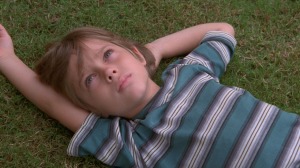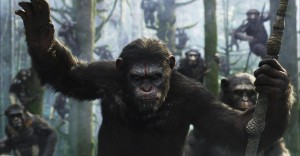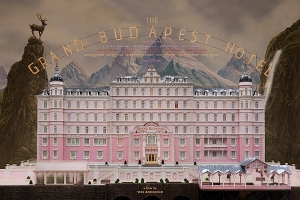Richard Linklater’s Boyhood is the biggest critical darling in recent memory – indeed, it’s the only film on Metacritic to reach a 100% approval rate on its initial release. I struggle to add anything to the conversation that hasn’t already been said at length, but I’ll start at least by saying that the film is just as staggering, brilliant, and moving as everybody else has lead you to believe. For the three of you who aren’t already aware of the premise, every year for 12 years, director Richard Linklater made on short film with the same cast, most of them centering on a young boy played by Ellar Coltrane and his relationships with his divorced parents. After 12 years – at which point the boy had grown to be a young man entering college – Linklater cut the short films together and released them as one narrative. This might sound like a gimmick on paper, but it’s hard to overstate how powerful and unique the effect is onscreen. Yes, many critics have cited the Harry Potter films and the 7 Up series as precedents for watching children growing up on camera (and you could go back at least as far as Francois Truffaut’s “Antoine” tetralogy if you’re really intent on playing “who did it first”). But those are all instances of watching children grow up over the course of multiple films; they essentially take place in real-time, because you actually have to wait seven years to see the cast of the Up series age another seven years. Boyhood, the other hand, compresses that experience into one two-and-a-half hour sitting, and it attempts to forge a coherent movie-length narrative from this expanse of time. The gradual realization that the characters onscreen are literally growing a year older every 10 minutes – not through makeup, not through CGI, but through actual bodies that are aging onscreen – is as emotionally staggering as it is unprecedented. There are many films that try to represent the fleeting nature of childhood, but this is the first film I’ve come across that literally captures it on-camera.
The sense of gradual growth extends to all aspects of the production. Linklater reportedly allowed his cast to improvise heavily, and did not have a set narrative end goal in mind when he started this long-form endeavor. While that loose framework might have led to the aimless, ramshackle quality of earlier Linklater movies like Slacker, improvisation in Boyhood rarely results in formlessness. Rather, Linklater and his cast’s open-ended approach enables the narrative and the characters to evolve organically. We see characters in their casual, everyday moments, but each of these moments, however seemingly mundane, is presented as a key insight into the way these characters are constantly developing as human beings.
This sense of development holds for both the characters and the actors who play them. It’s most dramatic for Ellar Coltrane, who stars as Mason, the “boy” of the Boyhood. Mason remains a quiet, sensitive young man throughout Boyhood, but as the film progresses, we see him grow from a child who wears his vulnerability on his sleeve into a teenager who tries to mask that vulnerability in sarcasm and philosophical musings (Mason will likely be spending much of his time in college watching Linklater’s Waking Life). Coltrane grows from being a great child actor to being a legitimately promising adult actor, and one can only imagine that his natural sincerity onscreen was informed by his own experience of simply becoming a teenager. The same extends to the adults in the film. Patricia Arquette gives an uncharacteristically raw performance as Mason’s struggling single mother, but her intensity from the earlier scenes gradually subsides as her children mature and she loses her fear that their futures hang on her life decisions. Ethan Hawke essentially reprises his affable Before Midnight persona as Mason’s life-lesson spouting father (so much so that I half-wonder if this is what Hawke is actually like when the cameras are off), but he also laces each cocky joke and charming smile with a sense of guilt and sadness that grows more pronounced as the film progresses. Time’s passage seems to render him acutely aware that while he can play the part of a sage benevolent father to his children, he’s only able to do so because he only sees them at sporadic intervals.
None of this is ever stated directly, thankfully. The film touches on a wide range of themes ranging from divorce, alcoholism, bullying, and teenage romance, but the film never makes a point of being “about” any of these themes; they’re simply incidents that pass through one family’s lives over the course of a decade. For all of the widespread praise the film has received, Linklater seems to have little interest in being overtly cinematic or artful – this is not a Terence Malik-inspired tone poem on the nature of human existence. But by observing characters with a casual, nonjudgmental eye and allowing their growth to dictate the terms of the story, Linklater and his crew have creating something just as profound. It wouldn’t be fair to claim that the film captures some sort of universal experience, as this is very much the story of one relatively privileged middle-class family dealing with middle-class problems. But the film’s unassuming and unsensational treatment of one family making its way through the decade captures something raw and piercing about the passage of time, and it’s unlikely that we’re ever going to see anything quite like it again.
The score:
Calling this a “score” review is something of a misnomer, as the film does not have a traditional score (at least in the instrumental non-diegetic sense of the word). That said, the soundtrack is guided by brilliant song choices that perfectly capture the larger pop and indie trends of the past decade. The director apparently commissioned actual young friends and acquaintances to help curate the songs on the soundtrack, and the result is a much more honest account of what young people in the mid-2000s were actually listening to than Linklater could have hoped for if he’d relied on a studio marketing department to compile the soundtrack. The approach also leads to a refreshingly eclectic compilation, ranging from Britney Spears to Gnarls Barkley, The Black Keys, Arcade Fire, and even John Williams’ Harry Potter music (a cue from Harry Potter and the Prisoner of Azkaban plays during a midnight Harry Potter book event – I’m somewhat embarrassed that I immediately recognized the piece as “The Whomping Willow,” a cue where the Harry Potter theme isn’t even present). As great as the music itself is, it’s also deployed with subtlety. Songs are rarely foregrounded for long; more often than not, we only hear brief snippets of songs in the background of bars, dorm rooms, and car stereos. And while each song is likely to carry its own emotional triggers for individual audience members, the film doesn’t use the music to goose up the audience’s emotions – there are no weepy montages where the music is supposed to carry the film. Rather, the music provides insight into the characters’ own tastes and personalities – the songs play because this is the music that these specific characters connect with at these specific points in their lives.
In the rare occasions where music does rise to the foreground, it’s less because the movie is trying to use a song to make a point and more because the characters are. That dynamic is particularly compelling in a scene where Mason Sr., Hawke’s character, gives his adolescent son a mix CD for his birthday. The CD, which Mason Sr. has proudly dubbed, “The Black Album” (adorably oblivious to Jay-Z, apparently), is a compilation of post-Beatles solo songs from Starr, Harrison, Lennon, and McCartney – the equivalent of a “new” Beatles album, he explains. In a scene that was apparently drawn from something the real Ethan Hawke did for his daughter, Mason’s father tries to use this compilation as a life lesson about the value of collaboration; he urgently tries to impress on his son that together, these songs elevate each other, for each Beatle’s solo work gains new meaning when it comes into conversation with his other former bandmates’ songs. But where the film could easily take this sweet idea at face value, instead it uses the father’s CD as a site for generational tension. Mason is now at an age where he’s starting to have his own ideas about music, and he quietly pushes against his father’s insistence that he appreciate all of these songs on his father’s terms. Because Mason Sr. has prepared this album as a statement, not an entry point for conversation, he’s visibly agitated when it seems that his son might be resisting the premise of his carefully rehearsed pearl of wisdom. For if his son now has his own opposing opinions about the music, Mason Sr. is forced to face the fact that his children are not always going to take his subjective thoughts on art and music as gospel; a new generation will eventually assign its own values to these songs. Thus when Paul McCartney’s “Band on the Run” plays to cap off this scene, it doesn’t emphasize the father’s message so much as it emphasizes the lingering tension in the air. The music in this scene doesn’t dictate meaning or emotion; instead, it reminds us that meaning and emotion in music are constantly in flux, shifting as different generations negotiate their own relationships with popular culture.
The scene is illustrative of the film’s overall ambivalent approach to music – songs in Boyhood serve less to amplify emotion than they do to reveal different aspects of the characters and the culture they inhabit. While the music is rarely dramatically vital to the story as a result, this is hardly a bad thing. Rather, the music’s subtlety is in keeping with the rest of the film; rather than force an interpretation on the audience, it gracefully gives the characters and their stories the space to develop on their own terms.
Film: * * * * *
Score: NA, but * * * * for the diegetic song choices.








